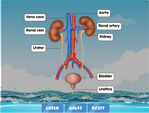The neuron diagram labelling quiz
The neuron, or nerve cell, is the most basic unit that composes the brain. It is a cell specialized to transmit electrical and chemical signals to other cells. These signals allow the brain to control and communicate with the rest of the body.
Navigating the Complex World of Neurons through Interactive Labeling
From the tiniest twitch of a finger to the most intricate thoughts, everything we do can be traced back to our brain's activity. Neurons, the specialized cells within our nervous system, play a pivotal role in transmitting messages throughout our body. For budding biologists, understanding the structure of these critical cells is fundamental. But how can one make the intricate task of labelling a neuron both engaging and educational? Enter the world of interactive gaming, where labeling becomes more than just rote memorization—it transforms into a thrilling exploration!
What is a Neuron? A Brief Overview
Before diving into the game, it's essential to familiarize ourselves with what a neuron is. In essence, neurons are the building blocks of our nervous system. These cells transmit electrical and chemical signals, enabling us to move, think, feel, and perform countless other tasks. Each neuron consists of various parts, each with its specific function, making the labelling of neuron structures crucial for understanding its workings.
The Challenge: Interactive Neuron Labelling
While textbook diagrams offer a static representation of a neuron's structure, interactive games bring these cells to life. For young learners, visualizing and interacting with these complex structures in a game format can significantly enhance comprehension and retention.
The Neuron Diagram Labelling Quiz: Dive into this interactive challenge, where players can test their knowledge by labeling a neuron. With dynamic feedback and an intuitive interface, this game promises both education and enjoyment in equal measure.
Beyond Neurons: Exploring the Vast World of Biology
Neurons are just one piece of the vast biological puzzle. Once learners have mastered the neuron to label, they can explore a plethora of other interactive educational games that delve into different aspects of biology.
Dive Deeper with ESL Games Plus Science Games: From the intricacies of cellular biology to the wonders of animal physiology, this platform offers a multitude of games designed to make learning complex subjects both fun and memorable.
Illuminating Young Minds: The Power of Interactive Biology
In today's digital age, traditional teaching methods are rapidly being supplemented, and in some cases replaced, by interactive learning platforms. Games, especially those like the neuron labelling challenge, not only provide an engaging learning experience but also ensure that knowledge is retained longer. As learners embark on this digital journey, they're not merely playing—they're diving deep into the heart of biology, understanding, and appreciating the wonders that lie within.
Approximately 80 billion neurons in the nervous system send and receive signals all the time. As a whole, they enable several bodily and mental processes, from digestion and breathing to thought, emotion, and consciousness.
The structure of the neuron is divided into three main parts – the dendrite, cell body or soma, and axon.
The dendrites branch out of the cell body and receives signals from the ends of other neurons. These signals travel along a tube called an axon, which is coated with a myelin sheath enabling them to travel faster to the axon terminals at the end.
Signals cross from the axon terminals of one neuron to the dendrites of another cell through a gap called the synapse.
The neuron diagram labelling quiz prepared here can serve as a helpful study aid for learning the various parts and functions of the nerve cell and how they work together in contributing to the function of the nervous system.











